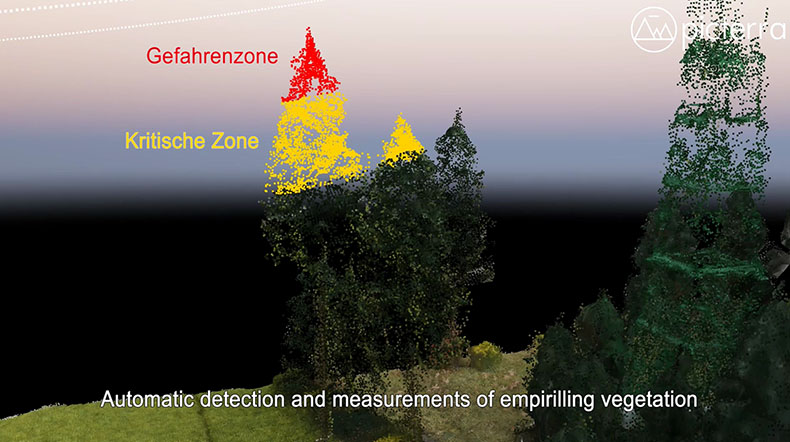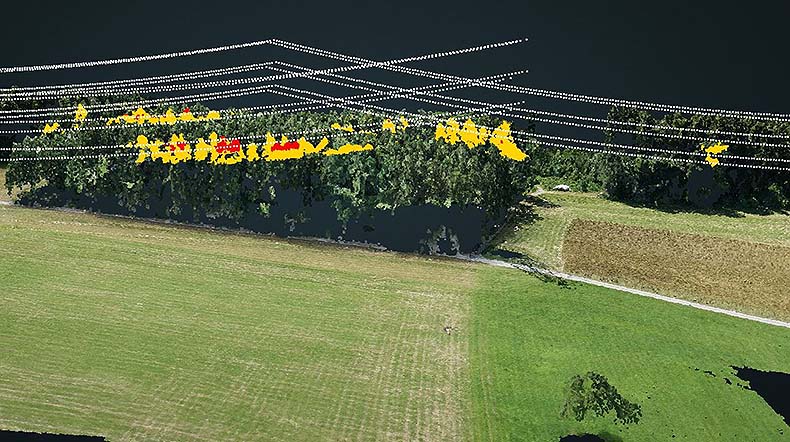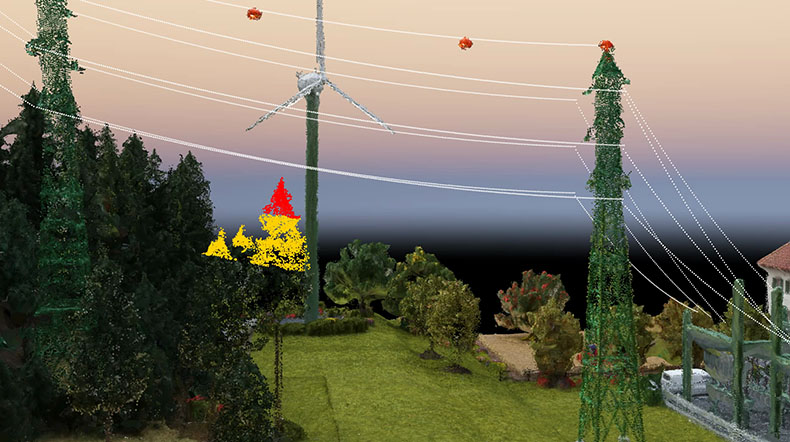When electricity is on the line
Leica UAV brings efficiency to vegetation management

Providing electricity to a whole country is a demanding task. It gets even more demanding when roughly one-third of the country is covered with woods and the other two-thirds contain Europe’s highest summits, the Alps.
To provide undisturbed supply and keep the electricity streaming, the Alpiq EnerTrans AG integrated Leica Geosystems Unmanned Aerial Vehicle (UAV) solutions into their workflow to manage visual inspections of the powerlines, their insulators and their poles. Evolving the use of an UAV to improve workflows, Alpiq EnerTrans AG took it to the next level, creating an innovative way for vegetation management, monitoring the environment threatening aerial cables using Leica Geosystems hexacopter.
Vegetation management from the air
Regular monitoring of the environment around infrastructural constructions is the first step in vegetation management. These structures include:
- Powerlines
- Pipelines
- Railways
The next step is planning and conducting the maintenance work to prevent any incidents. Therefore, a minimum distance between the surrounding flora and the lines is necessary. This is majorly important when it comes to aerial powerlines. As an insulating layer would be too heavy, the air around the lines works as a non-conducting protection. To prevent any short circuit, neither the lines to each other nor any vegetation should come closer than the minimum distance.
Earth faults and short circuits can cause heavy damage, fire and even lead to the teardown of a line, which could mean a power blackout for thousands of people. The minimum gap depends on the national laws, the operating voltage and a customised offset given by the company.
In the past, Alpiq EnerTrans AG was using experts to walk next to the powerlines to estimate the space between the conductions and the vegetation, to see if anything would interfere with the minimum gap. In doubt, the whole segment of the conduction had to be shut down and the crew had to climb up to get a more detailed view.
Neither was this method very accurate, mainly because it was based on appraisals, nor was it very efficient. With most of the constructions being built in difficult terrain, the inspections were very time consuming and it was a major effort for the crew to inspect the powerlines through the rough terrain. Apart from this method, Alpiq EnerTrans AG monitored its grid by using helicopters with infrared-, korona-, RGB-cameras, as well as laser scanners, to get ahead of possible threats caused by the environment
Alpiq was looking for new ways for their vegetation management and found their perfect match in an UAV based solution to:
- Raise efficiency
- Heighten safety
- Increase precision
Using an UAV to get as many details as the helicopter provided in combination with the benefit of small crews and light equipment was the perfect combination of versatility and granularity. To capture every data pertinent for the analysis, a Sony Alpha 7R with its full-frame CMOS-sensor (36.4megapixel) and a 28 mm lens is mounted onto the UAV’s gimbal.
The first step in using an UAV to monitor the environment surrounding the powerlines is to prepare the flight plan. Every segment to be monitored later has to be surveyed before the flight to get a detailed view of the states and possible danger spots. This becomes important when the crew is planning the most efficient waypoint flight in the next step.
The in-house built flight planning software calculates the most efficient route, the Ground Sampling Distance (GSD) and height of the UAV showing you the duration and waypoints of the whole operation. Another way to get ahead of this task, especially when the area is hard to predict, is the teach-in-function, where the UAV saves the waypoints from the flight to remember them the next time at this place.
To increase the precision, the a RTK/GNSS module can be attached and references the UAV with a scope of 1-3cm. This method is based on the technology of NovaTel and Leica Geosystems.
After the expulsion of the overhead lines, further processing of the data begins. The recorded images are georeferenced with the GPS data of the UAV’s logfile in a special software. Through the georeferenced data, an accurate 3D point cloud of the area and the environment is created.
In the next step, data of the position and the height of the poles are added and the models gets referenced through the GPS coordinates of the poles. After the model is set, computed conductions are added, to simulate the maximum conductor coil sag.
In the further process, the calculated point cloud is given to the Swiss company picterra GmbH. The software determines the distances between vegetation and power lines. Those points are marked in the point cloud at which the minimum distance is determined. A situation plan is derived from the model that shows the hazards as well as the parcel boundaries and numbers, roads, paths, lines and mast designations. On the basis of the situation plan, the coordinates of the hazard points can be clearly located.
Finding the right gap
By using the Leica Geosystems UAV solution, Alpiq has now been able to accurately determine the distances between the overhead lines and the surrounding vegetation to as much as ± 30cm in order to ensure a smooth operation of their routes. Since the current paths must frequently be checked at irregular intervals, the full potential of the UAV develops, in this case, in order to generate exact and comparable results from partial sections.
The entire monitoring can now be carried out by a small crew, since only one other person is required to watch HD live transmission on the screen. The cost advantage compared to a helicopter and the associated crew as well as the elaborate sensors is obvious. Another advantage of using an UAV is the possibility to generate precise data again and again in order not only to create snapshots but to generate a longitudinal section for a long-term study from the data obtained.
Leica Geosystems UAV as a floating multisensor platform also offers the possibility to use other measuring methods. So, Alpiq EnerTrans AG is extending the workflow to a multispectral camera, such as the Parrot Sequoia, to determine the Normalised Differenced Vegetation Index (NDVI) of the vegetation. This can identify regions that need to be inspected more frequently due to increased plant growth. This operation eliminates the need for expensive and large-scale inspections with helicopters, as areas where the overhead lines are threatened by vegetation can be predicted precisely.
The UAV is also equipped with a LiDAR sensor to achieve even more precise results. By using a LiDAR sensor, the UAV can generate millimeter-precision point clouds from the air and thus work even more precisely.
The advantages of collecting data for track management with an UAV are not only the reduction of costs and increased security. Rather, the UAV based open-line monitoring is a multiple flexible and allows selective and highly precise vegetation management. While in the case of an on-site inspection or the use of a helicopter, only momentary recordings are collected. The workflow generates data with an UAV, from which various scenarios can be simulated and analysed. This makes it possible not only to identify an actual situation but also to make detailed forecasts.
"The aerial robot from Leica Geosystems supports Alpiq EnerTrans AG optimally in the fulfillment of our demanding inspection tasks. A device for professionals by professionals!" - Rudolf Meier, chief executive of Alpiq EnerTrans AG
With the innovative approach of Alpiq EnerTrans AG to specify and modernise vegetation management through the use of Leica Geosystems UAV, the company not only works more efficiently, but it can also depend on solid data to counteract any malfunction.



























